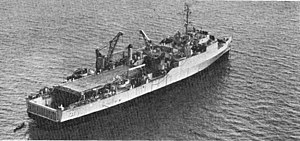USS Point Defiance (LSD-31)
 |
|
| History | |
|---|---|
| Name: | USS Point Defiance |
| Awarded: | 28 February 1952 |
| Builder: | Ingalls Shipbuilding, Pascagoula, Mississippi |
| Laid down: | 23 November 1953 |
| Launched: | 28 September 1954 |
| Commissioned: | 31 March 1955 |
| Decommissioned: | 30 September 1983 |
| Struck: | 24 February 1992 |
| Honors and awards: |
10 campaign stars (Vietnam) |
| Fate: | Sold for Scrapping 28 July 2011 to All Star Metals, Brownsville, Tx |
| Status: | undergoing scrapping |
| General characteristics | |
| Class and type: | Thomaston-class dock landing ship |
| Displacement: |
|
| Length: | 510 ft (160 m) |
| Beam: | 84 ft (26 m) |
| Draft: | 19 ft (5.8 m) |
| Propulsion: | 2 × steam turbines, 2 shafts, 23,000 shp (17 MW) |
| Speed: | 21 knots (39 km/h; 24 mph) |
| Boats & landing craft carried: |
21 × LCM-6 landing craft in well deck |
| Troops: | 300 |
| Complement: | 304 |
| Armament: |
|
| Aircraft carried: | One helicopter |
| Aviation facilities: | Helicopter landing area usually of wood construction; no hangar |
USS Point Defiance (LSD-31) was a Thomaston-class dock landing ship of the United States Navy. She was named for a location in Pierce County, Washington, the site of a military reservation established by the U.S. Government in 1866. She was the second ship assigned that name, but the construction of the Casa Grande-class dock landing ship Point Defiance (LSD-23) was canceled on 17 August 1945.
Point Defiance (LSD–31) was laid down on 23 November 1953 by Ingalls Shipbuilding Corp., Pascagoula, Miss.; launched on 28 September 1954, sponsored by Mrs. Arthur D. Struble; and commissioned on 31 March 1955, Commander Oscar B. Parker in command.
Following shakedown in the Gulf of Mexico, the new dock landing ship arrived Long Beach, California, in July 1955 and joined Amphibious Squadron 7, Amphibious Force, Pacific Fleet.
After two deployments to the western Pacific, Point Defiance became one of the first rocket-launching surface ships to support the 1958 International Geophysical Year Solar Eclipse Expedition to the South Pacific. Launchers on deck fired eight Nike-Asp sounding rockets to collect scientific data during the eclipse.
In May 1959 Point Defiance participated in the large scale and highly successful amphibious "Operation Twin Peaks" off Oceanside, California In February 1960 Point Defiance made her third cruise to the western Pacific, participating in "Operation Blue Star", a combined amphibious operation with Chinese Nationalist Forces. In June 1960 she participated in "Operation Sea Hawk", a combined amphibious landing with Republic of Korea forces and returned to Long Beach in July.
...
Wikipedia
